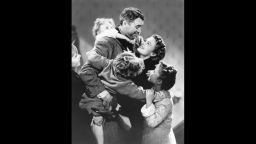Editor’s Note: This essay is part of a column called The Wisdom Project by David Allan, editorial director of CNN Health and Wellness. The series is on applying to one’s life the wisdom and philosophy found everywhere, from ancient texts to pop culture. You can follow David at @davidgallan. Don’t miss another Wisdom Project column by subscribing here.
Story highlights
We are all George Bailey. We don't fully appreciate what we have or what we accomplish
There's value in not doing "great things," but small things in a great way
The big life lesson from the eminent Christmas perennial, Frank Capra’s “It’s a Wonderful Life,” comes late in the film, delivered straight from heaven. “Each man’s life touches so many other lives,” explains Clarence Odbody, Angel Second Class. “When he isn’t around, he leaves an awful hole, doesn’t he?”
Our lives are full of wonder, it seems, by the mere fact of our interconnectedness. “We are here to help each other get through this thing, whatever it is,” wrote Kurt Vonnegut. Remove one Jenga piece and the tower begins to wobble.
At the start of the 1946 cinema gem, we witness a highlight reel in the seemingly ordinary life of the main character, George Bailey, within the confines of little Bedford Falls, New York. But on the way to nowhere, Bailey rescues his little brother from drowning, saves another kid from getting accidentally poisoned, helps locals build new homes, falls in love and has four precocious children.
These and other actions all have reverberations. “Hier zu sein ist so veil” (“To be here is immense”) wrote the poet Rilke. The fallout of George’s actions doesn’t become clear until he experiences a dystopian version of history in which he never existed.
In the alternative reality, a ship full of soldiers in World War II die because they weren’t saved by the war hero brother that George saved from drowning. The town chemist goes to jail for decades for the accidental death of the other kid. The whole town warps into a den of vice and slums because George’s greedy nemesis, the immoral Henry Potter, goes unimpeded. And worst of all, judging by the horror on George’s face when he learns her fate, his wife becomes a spinster librarian.
The parallel universe demonstrates for Bailey the obvious fact that everything a person does affects (positively or negatively) others.
But that’s not the real wisdom of the film.
Bailey isn’t struck by what an important cog he is in the gears of a Bedford Falls progress machine. His real moment of epiphany, as he pleads to Clarence to end his never-been-born nightmare, is to return to all the things he loved.
He just wants what he already had, the life he now realizes he failed to appreciate as wonderful.
The hidden ‘Life’
As we watch his life unfold from elementary school to adulthood, George Bailey becomes a profile of quiet desperation. His heart longs to travel overseas and be a famous architect, but his various plans are thwarted by everything from the death of his father to the Great Depression. He’s stuck in a job he seems to hate while his friends and brother are living out the adventures he desires for himself.

He knows his job helps people, he knows he’s a decent man, that he has a lovely wife and darling children and lives in a community of well-meaning friends and family, but that’s not enough for him.
Before his celestial intervention, George is so profoundly unhappy with his cloyingly small-town life that all it takes is a missing $8,000 from his business and the threat of bankruptcy and disgrace to tip the scales in favor of suicide.
We are all George Bailey. We have dreams unrealized. We are stressed by daily life. We don’t fully appreciate what we have, or by what we’ve managed to accomplish despite our obstacles. We are too often focused on the wrong things. And we are closer than we realize to a huge, catastrophic meltdown triggered by a single financial calamity.
But we’re also capable of re-creating Bailey’s profound realization. “Though we live much of our lives outside, in action and engagement in the world, the deeper impact of what happens is registered in the narrative of the heart,” writes the poet John O’Donohue in his collection “To Bless the Space Between Us.”
O’Donohue’s superpower is similar to Clarence the angel’s: to tease out the sublime meaning in ordinary moments. “Without our ever noticing, the heart absorbs the joy of things and also their pain and care,” he writes, seemingly of George Bailey’s wonderful life, and then of the character’s epiphany, “It is wise now and again to tune in to your heart and listen for what it carries. Sometimes the simplest things effect unexpected transformation.”
The real lesson of “It’s a Wonderful Life” is that what you think you want out of life and how we spend our days in it, may not be nearly as important as the vital layers accumulating within you, hidden in plain sight.
Love for friends and family, the decency we exchange with those around us, the value of not doing “great things” but small things in a great way. Those are life’s moments inscribed in our heart. And what this wonderful film reminds us to do – should auld lessons be forgot and never brought to mind – is to take our heart out and read it every so often. At least every Christmas.







